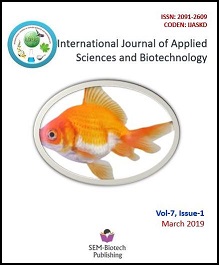Prevalence of Thermophilic Campylobacter Isolated from Water Used in Slaughter House of Kathmandu and Ruphendehi District, Nepal
DOI:
https://doi.org/10.3126/ijasbt.v7i1.23306Abstract
Campylobacter is a fastidious organism that is capable of surviving in wide range of environments and potentially can cause serious infection in human and animal which can commonly available in the different sources of water used for daily purpose. This research was conducted to figure out the prevalence of the thermophilic Campylobacter in the water used in various slaughter houses of Kathmandu and Ruphendehi district of Nepal. So a cross sectional study was conducted and 200 water samples (100 for each district) was collected aseptically and submitted to Bacteriological Unit for the confirmation. Isolation and identification of Campylobacter was being done as described by OIE Terrestrial Manual, 2004, Chapter 2.8.10. Laboratory finding was done to confirm the positive cases. The study revealed the prevalence status of Campylobacter in water used in the slaughter house of Ruphendehi district is 12% and Kathmandu Valley is 0.00%. Thus, Ruphendehi has comparatively more prevalence of Campylobacter than Kathmandu. The water samples tested were all from actual or potential water sources for the use in slaughter house, so there are clear implications for the transmission of Campylobacter spp. to human and animal suggesting further expanded research is required in this area.
Int. J. Appl. Sci. Biotechnol. Vol 7(1): 75-80




